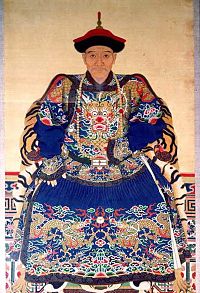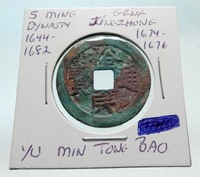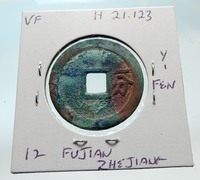China - Qing Rebel (Ming-Qing Transition)
Geng Jingzhong - Ruled: 1674-1676 A.D.
Bronze Cash 30mm
You are bidding on the exact item pictured, provided with a Certificate of Authenticity and Lifetime Guarantee of Authenticity.
Cash was a type of coin of China and East Asia, used from the 4th century BC until the 20th century AD. Originally cast during the Warring States period, these coins continued to be used for the entirety of Imperial China as well as under Mongol, and Manchu rule. The last Chinese cash coins were cast in the first year of the Republic of China. Generally most cash coins were made from copper or bronze alloys, with iron, lead, and zinc coins occasionally used less often throughout Chinese history. Rare silver and gold cash coins were also produced. During most of their production, cash coins were cast but, during the late Qing dynasty, machine-struck cash coins began to be made. As the cash coins produced over Chinese history were similar, thousand year old cash coins produced during the Northern Song dynasty continued to circulate as valid currency well into the early twentieth century. In the modern era, these coins are considered to be Chinese "good luck coins"; they are hung on strings and round the necks of children, or over the beds of sick people. They hold a place in various superstitions, as well as Traditional Chinese medicine, and Feng shui. Currencies based on the Chinese cash coins include the Japanese mon, Korean mun, Ryukyuan mon, and Vietnamese văn.
 Geng Jingzhong (Chinese: 耿精忠; pinyin: Gěng Jīngzhōng; Wade-Giles: Keng Ching-chung; died 1682) was a powerful military commander of the early Qing dynasty. He inherited the title of "King/Prince of Jingnan" (靖南王) from his father Geng Jimao, who had inherited it from Jingzhong's grandfather Geng Zhongming. Geng Jingzhong (Chinese: 耿精忠; pinyin: Gěng Jīngzhōng; Wade-Giles: Keng Ching-chung; died 1682) was a powerful military commander of the early Qing dynasty. He inherited the title of "King/Prince of Jingnan" (靖南王) from his father Geng Jimao, who had inherited it from Jingzhong's grandfather Geng Zhongming.
The "Dolo efu" 和碩額駙 rank was given to husbands of Qing princesses. Geng Jingmao managed to have both his sons Geng Jingzhong and Geng Zhaozhong 耿昭忠 become court attendants under the Shunzhi Emperor and get married to Aisin Gioro women, with Prince Abatai's granddaughter marrying Geng Zhaozhong 耿昭忠 and Hooge's (a son of Hong Taiji) daughter marrying Geng Jingzhong. A daughter 和硕柔嘉公主 of the Manchu Aisin Gioro Prince Yolo 岳樂 (Prince An) was wedded to Geng Juzhong 耿聚忠. Firmly entrenched as a quasi independent ruler in Fujian, in 1674 Geng Jingzhong rebelled against Qing rule along with the other two of the Three Feudatories Wu Sangui and Shang Zhixin, who were also governing enormous principalities in south China. Qing armies eventually defeated Geng, who surrendered to the Kangxi Emperor. The Qing then used Geng's troops to fight the other feudatories until the civil war ended. Soon after the Qing final victory in 1681, the Kangxi Emperor had Geng executed by slow slicing for treason. Geng Jingzhong's brother Geng Juzhong 耿聚忠 was in Beijing with the Qing court with the Kangxi Emperor during the rebellion and was not punished by the Kangxi Emperor for his brother's revolt. Geng Juzhong died of natural causes in 1687. Geng Juzhong was a Third Class Viscount 三等子. 
The transition from Ming to Qing or the Ming-Qing transition, also known as the Manchu conquest of China, was a decades-long period of conflict between the Qing dynasty, established by Manchu clan Aisin Gioro in Manchuria (contemporary Northeastern China), and the Ming dynasty of China in the south (various other regional or temporary powers were also associated with events, such as the short-lived Shun dynasty). Leading up to the Qing conquest, in 1618, Aisin Gioro leader Nurhaci commissioned a document entitled the Seven Grievances, which enumerated grievances against the Ming and began to rebel against their domination. Many of the grievances dealt with conflicts against Yehe, which was a major Manchu clan, and Ming favoritism of Yehe. Nurhaci's demand that the Ming pay tribute to him to redress the seven grievances was effectively a declaration of war, as the Ming were not willing to pay money to a former tributary. Shortly afterwards, Nurhaci began to rebel against the Ming in Liaoning in southern Manchuria. At the same time, the Ming dynasty was fighting for its survival against fiscal turmoil and peasant rebellions. On April 24, 1644, Beijing fell to a rebel army led by Li Zicheng, a former minor Ming official who became the leader of the peasant revolt, who then proclaimed the Shun dynasty. The last Ming emperor, the Chongzhen Emperor, hanged himself from a tree in the imperial garden outside the Forbidden City. When Li Zicheng moved against him, the Ming general Wu Sangui shifted his alliance to the Manchus. Li Zicheng was defeated at the Battle of Shanhai Pass by the joint forces of Wu Sangui and Manchu prince Dorgon. On June 6, the Manchus and Wu entered the capital and proclaimed the young Shunzhi Emperor as Emperor of China. The conquest was far from complete however, and it required almost forty more years before all of a China was securely united under Qing rule. The Kangxi Emperor ascended the throne in 1661, and in 1662 his regents launched the Great Clearance to defeat the resistance of Ming loyalists in South China. He then fought off several rebellions, such as the Revolt of the Three Feudatories led by Wu Sangui in southern China, starting in 1673, and then countered by launching a series of campaigns that expanded his empire. In 1662, Zheng Chenggong (Koxinga) drove out the Dutch colonists and founded the Kingdom of Tungning in Taiwan, a Ming loyalist state with a goal of reconquering China. However, Tungning was defeated in 1683 at the Battle of Penghu by Han admiral Shi Lang, a former admiral under Koxinga. The fall of the Ming dynasty was largely caused by a combination of factors. Kenneth Swope argues that one key factor was deteriorating relations between Ming Royalty and the Ming Empire's military leadership. Other factors include repeated military expeditions to the North, inflationary pressures caused by spending too much from the imperial treasury, natural disasters and epidemics of disease. Contributing further to the chaos was a peasant rebellion in Beijing in 1644 and a series of weak emperors. Ming power would hold out in what is now southern China for years, though eventually would be overtaken by the Manchus.
|


 Geng Jingzhong (Chinese: 耿精忠; pinyin: Gěng Jīngzhōng; Wade-Giles: Keng Ching-chung; died 1682) was a powerful military commander of the early Qing dynasty. He inherited the title of "King/Prince of Jingnan" (靖南王) from his father Geng Jimao, who had inherited it from Jingzhong's grandfather Geng Zhongming.
Geng Jingzhong (Chinese: 耿精忠; pinyin: Gěng Jīngzhōng; Wade-Giles: Keng Ching-chung; died 1682) was a powerful military commander of the early Qing dynasty. He inherited the title of "King/Prince of Jingnan" (靖南王) from his father Geng Jimao, who had inherited it from Jingzhong's grandfather Geng Zhongming. 

